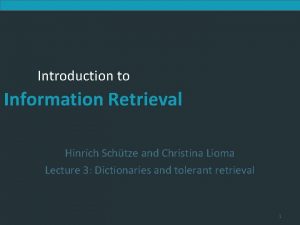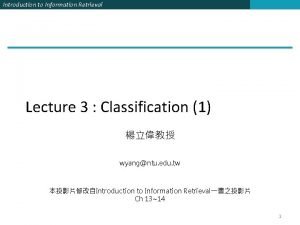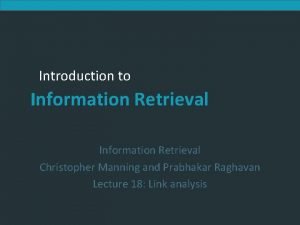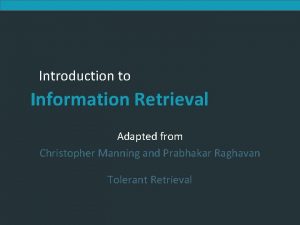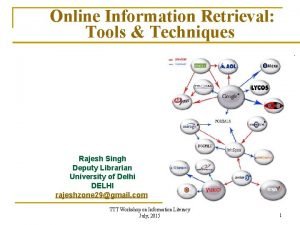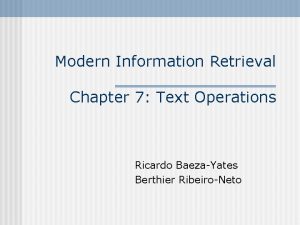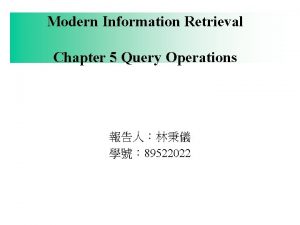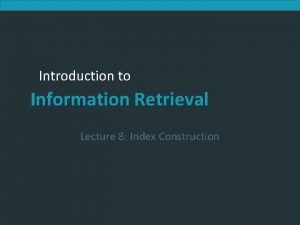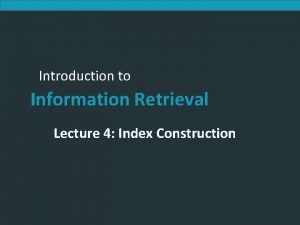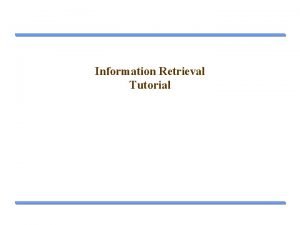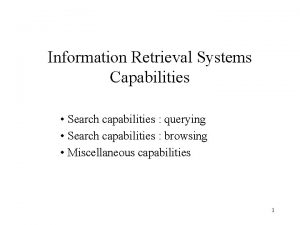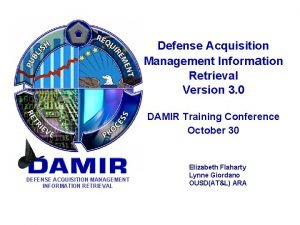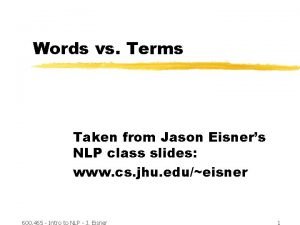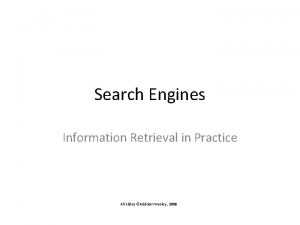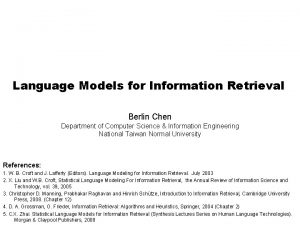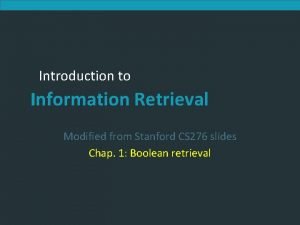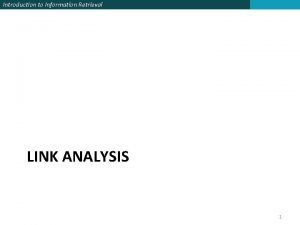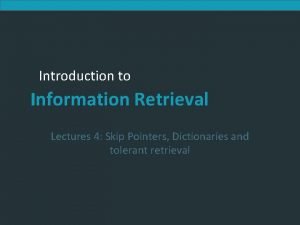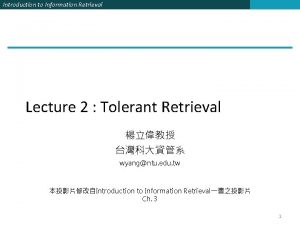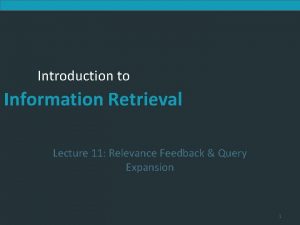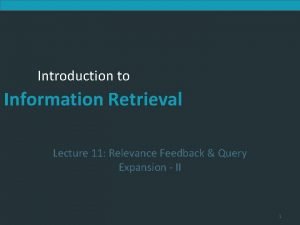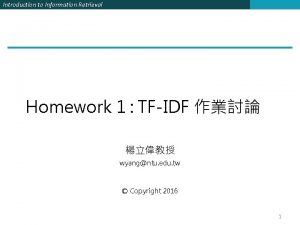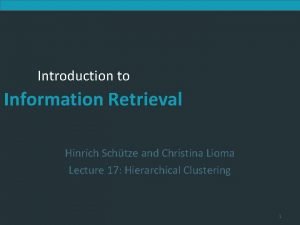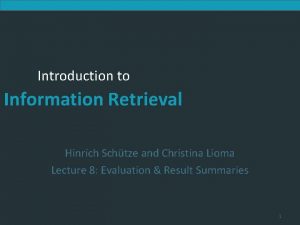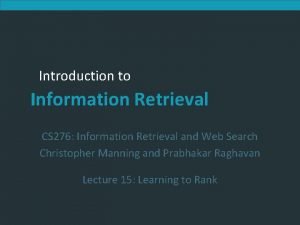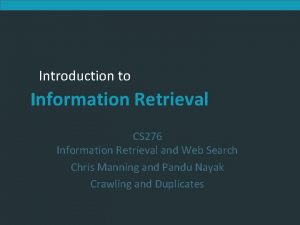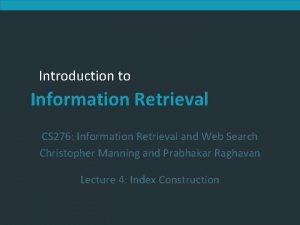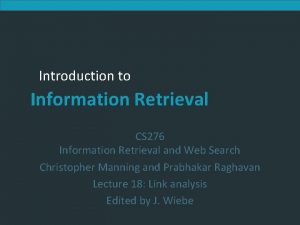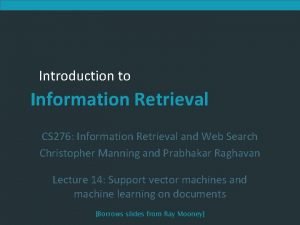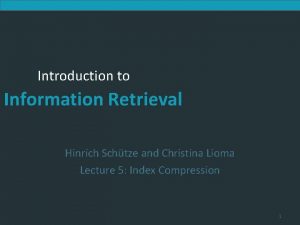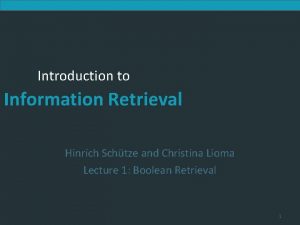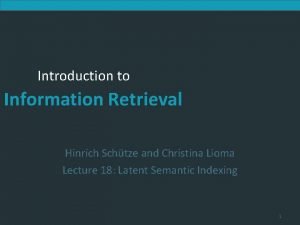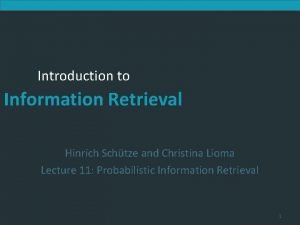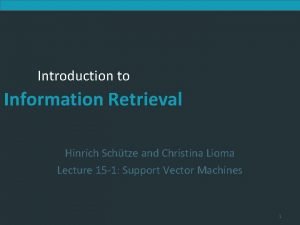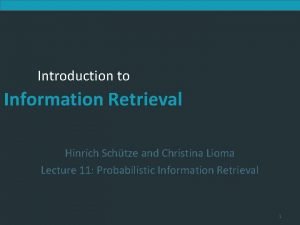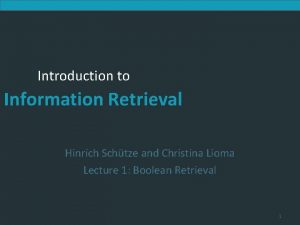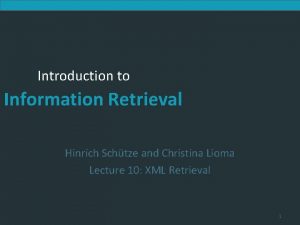Introduction to Information Retrieval Hinrich Schtze and Christina














































- Slides: 46

Introduction to Information Retrieval Hinrich Schütze and Christina Lioma Lecture 20: Crawling 1

Introduction to Information Retrieval Overview ❶ Recap ❷ A simple crawler ❸ A real crawler 2

Introduction to Information Retrieval Outline ❶ Recap ❷ A simple crawler ❸ A real crawler 3

Introduction to Information Retrieval Search engines rank content pages and ads 4

Introduction to Information Retrieval Google’s second price auction § bid: maximum bid for a click by advertiser § CTR: click-through rate: when an ad is displayed, what percentage of time do users click on it? CTR is a measure of relevance. § ad rank: bid × CTR: this trades off (i) how much money the advertiser is willing to pay against (ii) how relevant the ad is § paid: Second price auction: The advertiser pays the minimum amount necessary to maintain their position in the auction (plus 1 cent). 5

Introduction to Information Retrieval What’s great about search ads § Users only click if they are interested. § The advertiser only pays when a user clicks on an ad. § Searching for something indicates that you are more likely to buy it. . . §. . . in contrast to radio and newpaper ads. 6

Introduction to Information Retrieval Near duplicate detection: Minimum of permutation document 1: {sk} Roughly: We use are d 1 and d 2 near-duplicates? document 2: {sk} as a test for: 7

Introduction to Information Retrieval Example h(x) = x mod 5 g(x) = (2 x + 1) mod 5 final sketches 8

Introduction to Information Retrieval Outline ❶ Recap ❷ A simple crawler ❸ A real crawler 9

Introduction to Information Retrieval How hard can crawling be? § Web search engines must crawl their documents. § Getting the content of the documents is easier for many other IR systems. § E. g. , indexing all files on your hard disk: just do a recursive descent on your file system § Ok: for web IR, getting the content of the documents takes longer. . . §. . . because of latency. § But is that really a design/systems challenge? 10

Introduction to Information Retrieval Basic crawler operation § Initialize queue with URLs of known seed pages § Repeat § § Take URL from queue Fetch and parse page Extract URLs from page Add URLs to queue § Fundamental assumption: The web is well linked. 11

Introduction to Information Retrieval Exercise: What’s wrong with this crawler? urlqueue : = (some carefully selected set of seed urls) while urlqueue is not empty: myurl : = urlqueue. getlastanddelete() mypage : = myurl. fetch() fetchedurls. add(myurl) newurls : = mypage. extracturls() for myurl in newurls: if myurl not in fetchedurls and not in urlqueue: urlqueue. add(myurl) addtoinvertedindex(mypage) 12

Introduction to Information Retrieval What’s wrong with the simple crawler Scale: we need to distribute. We can’t index everything: we need to subselect. How? Duplicates: need to integrate duplicate detection Spam and spider traps: need to integrate spam detection Politeness: we need to be “nice” and space out all requests for a site over a longer period (hours, days) § Freshness: we need to recrawl periodically. § § § Because of the size of the web, we can do frequent recrawls only for a small subset. § Again, subselection problem or prioritization 13

Introduction to Information Retrieval Magnitude of the crawling problem § To fetch 20, 000, 000 pages in one month. . . §. . . we need to fetch almost 8000 pages per second! § Actually: many more since many of the pages we attempt to crawl will be duplicates, unfetchable, spam etc. 14

Introduction to Information Retrieval What a crawler must do Be polite § Don’t hit a site too often § Only crawl pages you are allowed to crawl: robots. txt Be robust § Be immune to spider traps, duplicates, very large pages, very large websites, dynamic pages etc 15

Introduction to Information Retrieval Robots. txt § Protocol for giving crawlers (“robots”) limited access to a website, originally from 1994 § Examples: § User-agent: * Disallow: /yoursite/temp/ § User-agent: searchengine Disallow: / § Important: cache the robots. txt file of each site we are crawling 16

Introduction to Information Retrieval Example of a robots. txt (nih. gov) User-agent: Pico. Search/1. 0 Disallow: /news/information/knight/ Disallow: /nidcd/. . . Disallow: /news/research_matters/secure/ Disallow: /od/ocpl/wag/ User-agent: * Disallow: /news/information/knight/ Disallow: /nidcd/. . . Disallow: /news/research_matters/secure/ Disallow: /od/ocpl/wag/ Disallow: /ddir/ Disallow: /sdminutes/ 17

Introduction to Information Retrieval What any crawler should do § Be capable of distributed operation § Be scalable: need to be able to increase crawl rate by adding more machines § Fetch pages of higher quality first § Continuous operation: get fresh version of already crawled pages 18

Introduction to Information Retrieval Outline ❶ Recap ❷ A simple crawler ❸ A real crawler 19

Introduction to Information Retrieval URL frontier 20

Introduction to Information Retrieval URL frontier § The URL frontier is the data structure that holds and manages URLs we’ve seen, but that have not been crawled yet. § Can include multiple pages from the same host § Must avoid trying to fetch them all at the same time § Must keep all crawling threads busy 21

Introduction to Information Retrieval Basic crawl architecture 22

Introduction to Information Retrieval URL normalization § Some URLs extracted from a document are relative URLs. § E. g. , at http: //mit. edu, we may have aboutsite. html § This is the same as: http: //mit. edu/aboutsite. html § During parsing, we must normalize (expand) all relative URLs. 23

Introduction to Information Retrieval Content seen § For each page fetched: check if the content is already in the index § Check this using document fingerprints or shingles § Skip documents whose content has already been indexed 24

Introduction to Information Retrieval Distributing the crawler § Run multiple crawl threads, potentially at different nodes § Usually geographically distributed nodes § Partition hosts being crawled into nodes 25

Introduction to Information Retrieval Google data centers (wazfaring. com) 26

Introduction to Information Retrieval Distributed crawler 27

Introduction to Information Retrieval URL frontier: Two main considerations § Politeness: Don’t hit a web server too frequently § E. g. , insert a time gap between successive requests to the same server § Freshness: Crawl some pages (e. g. , news sites) more often than others § Not an easy problem: simple priority queue fails. 28

Introduction to Information Retrieval Mercator URL frontier 29

Introduction to Information Retrieval Mercator URL frontier § URLs flow in from the top into the frontier. 30

Introduction to Information Retrieval Mercator URL frontier § URLs flow in from the top into the frontier. § Front queues manage prioritization. 31

Introduction to Information Retrieval Mercator URL frontier § URLs flow in from the top into the frontier. § Front queues manage prioritization. § Back queues enforce politeness. 32

Introduction to Information Retrieval Mercator URL frontier § URLs flow in from the top into the frontier. § Front queues manage prioritization. § Back queues enforce politeness. § Each queue is FIFO. 33

Introduction to Information Retrieval Mercator URL frontier: Front queues 34

Introduction to Information Retrieval Mercator URL frontier: Front queues § Prioritizer assigns to URL an integer priority between 1 and F. 35

Introduction to Information Retrieval Mercator URL frontier: Front queues § Prioritizer assigns to URL an integer priority between 1 and F. § Then appends URL to corresponding queue 36

Introduction to Information Retrieval Mercator URL frontier: Front queues § Prioritizer assigns to URL an integer priority between 1 and F. § Then appends URL to corresponding queue § Heuristics for assigning priority: refresh rate, Page. Rank etc 37

Introduction to Information Retrieval Mercator URL frontier: Front queues § Selection from front queues is initiated by back queues § Pick a front queue from which to select next URL: Round robin, randomly, or more sophisticated variant § But with a bias in favor of high-priority front queues 38

Introduction to Information Retrieval Mercator URL frontier: Back queues 39

Introduction to Information Retrieval Mercator URL frontier: Back queues § Invariant 1. Each back queue is kept nonempty while the crawl is in progress. § Invariant 2. Each back queue only contains URLs from a single host. § Maintain a table from hosts to back queues. 40

Introduction to Information Retrieval Mercator URL frontier: Back queues § In the heap: § One entry for each back queue § The entry is the earliest time te at which the host corresponding to the back queue can be hit again. § The earliest time te is determined by (i) last access to that host (ii) time gap heuristic 41

Introduction to Information Retrieval Mercator URL frontier: Back queues § How fetcher interacts with back queue: § Repeat (i) extract current root q of the heap (q is a back queue) § and (ii) fetch URL u at head of q. . . §. . . until we empty the q we get. § (i. e. : u was the last URL in q) 42

Introduction to Information Retrieval Mercator URL frontier: Back queues § When we have emptied a back queue q: § Repeat (i) pull URLs u from front queues and (ii) add u to its corresponding back queue. . . §. . . until we get a u whose host does not have a back queue. § Then put u in q and create heap entry for it. 43

Introduction to Information Retrieval Mercator URL frontier § URLs flow in from the top into the frontier. § Front queues manage prioritization. § Back queues enforce politeness. 44

Introduction to Information Retrieval Spider trap § Malicious server that generates an infinite sequence of linked pages § Sophisticated spider traps generate pages that are not easily identified as dynamic. 45

Introduction to Information Retrieval Resources § Chapter 20 of IIR § Resources at http: //ifnlp. org/ir § Paper on Mercator by Heydon et al. § Robot exclusion standard 46
 Wizfiz
Wizfiz Schtze
Schtze Christina computes
Christina computes Manning introduction to information retrieval
Manning introduction to information retrieval Introduction to information retrieval
Introduction to information retrieval Introduction to information retrieval
Introduction to information retrieval Introduction to information retrieval manning
Introduction to information retrieval manning What is precision and recall in information retrieval
What is precision and recall in information retrieval Information retrieval and web search
Information retrieval and web search Information retrieval data structures and algorithms
Information retrieval data structures and algorithms Information retrieval tools and techniques
Information retrieval tools and techniques Signature file structure in information retrieval system
Signature file structure in information retrieval system What is sequential search
What is sequential search Information retrieval architecture
Information retrieval architecture Text operations in information retrieval
Text operations in information retrieval Query operations in information retrieval
Query operations in information retrieval Skip pointers in information retrieval
Skip pointers in information retrieval Index construction in information retrieval
Index construction in information retrieval Index construction in information retrieval
Index construction in information retrieval Which internet service is used for information retrieval
Which internet service is used for information retrieval Information retrieval tutorial
Information retrieval tutorial Wildcard queries in information retrieval
Wildcard queries in information retrieval Search capabilities in information retrieval system
Search capabilities in information retrieval system Link analysis in information retrieval
Link analysis in information retrieval Information retrieval lmu
Information retrieval lmu Defense acquisition management information retrieval
Defense acquisition management information retrieval Advantages of information retrieval system
Advantages of information retrieval system Information retrieval nlp
Information retrieval nlp Information retrieval slides
Information retrieval slides Relevance information retrieval
Relevance information retrieval Information retrieval stanford
Information retrieval stanford Link analysis in information retrieval
Link analysis in information retrieval Skip pointers in information retrieval
Skip pointers in information retrieval Anthony julius
Anthony julius Information retrieval
Information retrieval Information retrieval
Information retrieval Information retrieval
Information retrieval Relevance information retrieval
Relevance information retrieval Information retrieval
Information retrieval Information retrieval
Information retrieval Information retrieval
Information retrieval Information retrieval
Information retrieval Relevance information retrieval
Relevance information retrieval Information retrieval
Information retrieval Cs 276
Cs 276 Information retrieval
Information retrieval Information retrieval
Information retrieval

